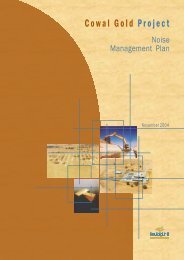Barrick Beyond Borders - May 2012 - Barrick Gold Corporation
Barrick Beyond Borders - May 2012 - Barrick Gold Corporation
Barrick Beyond Borders - May 2012 - Barrick Gold Corporation
You also want an ePaper? Increase the reach of your titles
YUMPU automatically turns print PDFs into web optimized ePapers that Google loves.
BEYOND BORDERS | A BARRICK GOLD REPORT ON RESPONSIBLE MININGheld in Dar es Salaam. Between 2008 and 2010, the Rafiki GalaDinner raised nearly $230,000.<strong>Barrick</strong>, ABG’s majority shareholder, has been supportingthe Rafiki Surgical Missions since 2004. In addition to the cleftlip and cleft palate surgical procedures, the program also fundsreconstructive surgeries that reverse damage caused by burn injuries.All told, <strong>Barrick</strong> and ABG have helped fund more than 870surgeries, many on children. Like Jumanne Maziku.Maziku, no relation to Rossa Maziku, was born with a cleft lip.His father abandoned the family shortly after Jumanne was bornbecause he believed his son’s condition was a curse that wouldbring misfortune on the family. Jumanne, who is five, underwentcorrective surgery at the age of two. “I am alone with two children,but the surgery gave my son hope for a better life,” says Jumanne’smother, Christina Maziku.Hope was a common theme expressed by families whose childrenunderwent surgery. “It was not in my thoughts that oneday my child would be treated,” says Mathew Makungu, whose13-year-old son, Daud, underwent cleft-lip surgery in 2011. “He isnow eating and talking properly and no longer isolated and teasedat school.”Cleft lip and cleft palate are congenital deformities caused byabnormal development during pregnancy. A cleft lip is a physicalsplit or separation of the two sides of the upper lip. A cleft palateis a split or opening in the roof of the mouth. People born witheither condition are often shunned by their peers, and suffer fromlow self-esteem and social anxiety.Cleft lip, with or without cleft palate, affects about one in 700babies. While the cause is unknown, the facial deformity canbe fixed by a relatively simple, one-hour operation. However, inTanzania, many families cannot afford the surgery and the publichealth system does not provide funding.ROSSA MAZIKU, 55, HAD CORRECTIVE SURGERY TO REPAIR HER CLEFT LIP ANDPALATE LAST YEAR. “I FEEL SO BEAUTIFUL NOW,” SHE SAYS. AT LEFT: JUMANNEMAZIKU BEFORE HE UNDERWENT SURGERY TO REPAIR HIS CLEFT LIP AND (FARLEFT) AFTER THE SURGERY.DR. ANDREW CROCKER, A PLASTICSURGEON FROM PERTH, HASPARTICIPATED IN TWO MISSIONS AND ISABOUT TO EMBARK ON A THIRD.Surgeries arranged by the Rafiki Surgical Mission are performedby doctors from Australia, who volunteer their time toparticipate in the missions. Volunteer teams include plastic surgeons,anesthetists, theater nurses and non-medical staff who helpwith logistics. While the teams’ airfare and accommodations arecovered by the program, they perform the surgeries – sometimesmore than 100 during each two-week mission – for free. They alsotrain local Tanzanian health care professionals on how to carryout the operations.“I think we all do it for, obviously, the benefit of the patients,”says Andrew Crocker, a plastic surgeon from Perth who has participatedin two missions, and is about to embark on a third. “Butit also gives you a feeling of intrinsic self-worth. You can make ahuge difference in someone’s life and you’re utilizing your talentsfor something worthwhile.”Crocker specializes in surgeries to reverse damage caused byburn injuries. There is only one burn unit, located in the capital ofDar es Salaam, in the country of 38 million people, Crocker says.Hence, many people who suffer burn injuries don’t receive propertreatment, he says.Burn injuries to the hands are common in Tanzania becausemany people cook over open fires or with highly flammable kerosenestoves, Crocker says. In many cases, scar tissue resultingfrom an untreated burn injury causes the fingers literally to fusetogether. The surgery that Crocker performs allows the fingers tostraighten and extend.“We usually can’t repair the damage completely, but patientsget a lot of the movement back,” Crocker says. “When a personwith a functional deformity realizes for the first time that functionalityhas been restored, they sometimes are very tearful. Theyreally do appreciate it.” ■<strong>May</strong> <strong>2012</strong> 37
















